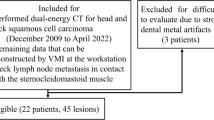Abstract
We compare four different three-dimensional (3D) reconstruction methods of spiral computed tomography (CT) data for head and neck cancer to establish the method best suited for specific uses, eg, staging of lymph nodes and viewing of spatial relationships between the tumor, fascial spaces, adjacent soft tissues, and others structures. We evaluated a series of 10 patients (six men and four women), aged 32 to 60 years. Of these, five were histologically diagnosed with squamous cell carcinoma, two with lymphoma, one with thyroid cancer, one with Kikuchi’s disease or necrotizing lymphadenitis, and one with esthesioneuroblastoma. All scans were obtained using highresolution spiral CT (General Electric Medical Systems, Milwaukee, WI). The collimations used were 3 mm and 5 mm, matrix 512 × 512, and reconstruction interval not more than 3 mm. Scanning was performed from the skull base to the aortic arch. Iodinated contrast medium was injected so that the blood vessels were clearly differentiated from nodes. Different techniques of three-dimensional reconstruction were employed, including shaded surface display (SSD), multiplanar reconstructions (MPR), maximum intensity projection (MIP), 3D volume rendering (VR), and combined techniques. The reconstructions were performed in a variety of planes, including sagittal, coronal, and oblique views. In our series of selected patients, the technique of 3D VR showed potential advantages over other techniques. The MIP technique was useful in analyzing the patency of vessels and to exclude thrombus, compression, or displacement by tumor. The use of combined techniques such as SSD and MPR, accurately demonstrated the levels of lymph nodes and the relationship between the tumor projection of interest and various anatomic structures. In conclusion, 3D reconstruction of CT data is useful in the localization and staging of neck tumors and assists in surgical planning and radiation treatment.
Similar content being viewed by others
References
Johnson JT: A surgeon looks at cervical lymph nodes. Radiology 175:607–610, 1990
Mancuso AA, Harnsberger HR, Maruki A, et al: Computed tomography of cervical and retropharyngeal lymph nodes: Normal anatomy, variants and applications in staging head and neck cancer. II Pathology. Radiology 148:715–723, 1983
Nason RW, Sako K, Beecroft WA, et al: Surgical management of squamous cell carcinoma of the floor of the mouth. Am J Surg 158:292–296, 1989
Snyderman NL, Johnson JT, Schramm VL Jr, et al: Extracapsular spread of carcinoma in cervical lymph nodes. Cancer 56:1597–1599, 1985
Curtin HD, Ishwaran H, Mancuso AA, et al: Comparison of CT and MR imaging in staging of neck metastasis. Radiology 207:123–130, 1998
Napel SA: Basic principles of spiral CT, in Fishman EK, Jeffrey RB (eds): Spiral CT. Principle, Techniques and Clinical Application (ed 2). Philadelphia, PA, Lippincott-Raven, 1998, pp 3–15
Goitein M: The utility of computed tomography in radiation therapy: An estimate of outcome. Int J Radiat Oncol Biol Phys 5:1799–1807, 1979
Fishman EK, Magid D, Ney DR, et al: Three-dimensional imaging. Radiology 181:321–337, 1991
Kalender WA, Polacin A: Physical performance characteristics of spiral CT scanning. Med Phys 18:910–915, 1991
Rubin GD: Three-dimensional helical CT angiography. Radiographics 14:905–912, 1994
Brink JA, Heiken JP, Wang G, et al: Principle and technical considerations. Radiographics 14:887–893, 1994
Udupa JK: Computer aspects of 3D imaging in medicine: A tutorial, in Uduap JK, Herman GT (eds): 3D Imaging (ed 2). Boca Raton, FL, CRC, 1999, pp 2–69
Prokop M, Shin H, Schanz A, et al: Use of maximum intensity projections in CT angiography: A basic review. Radiographics 17:433–451, 1997
Drebin RA, Carpenter L, Hanrahan P: Volume rendering. Comput Graph 22:65–74, 1988
Pelizzari CA, Grzeszczuk R, Chen GTY: Volumetric visualization of anatomy for treatment planning. Int J Radiat Oncol Biol Phys 34:205–211, 1996
Som PM: Lymph nodes, in: Som PM, Curtin HD (eds): Head and Neck Imaging, vol 2 (ed 3). St Louis, MO, Mosby Year Book, 1996, pp 772–793
Ramsey RG: Neck, in Neuroradiology (ed 3). Philadelphia, PA, Saunders, 1994, p 691
Author information
Authors and Affiliations
Corresponding author
Rights and permissions
About this article
Cite this article
Franca, C., Levin-Plotnik, D., Sehgal, V. et al. Use of three-dimensional spiral computed tomography imaging for staging and surgical planning of head and neck cancer. J Digit Imaging 13 (Suppl 1), 24–32 (2000). https://doi.org/10.1007/BF03167619
Issue Date:
DOI: https://doi.org/10.1007/BF03167619




